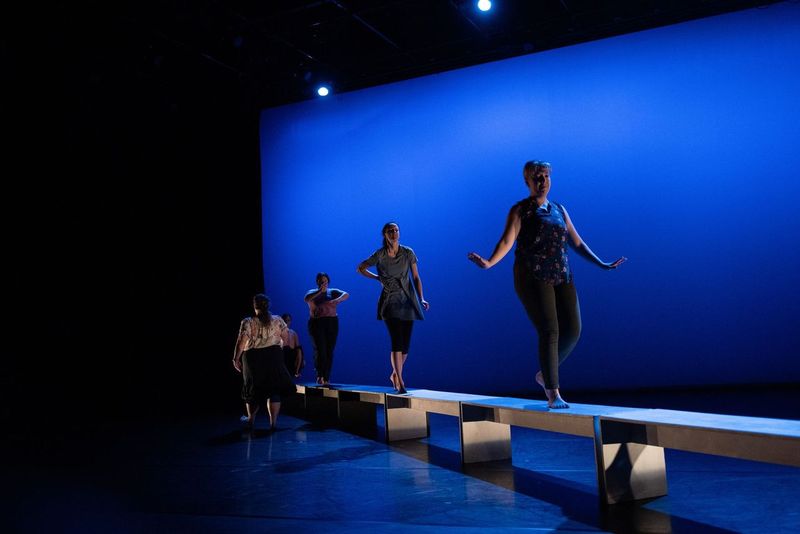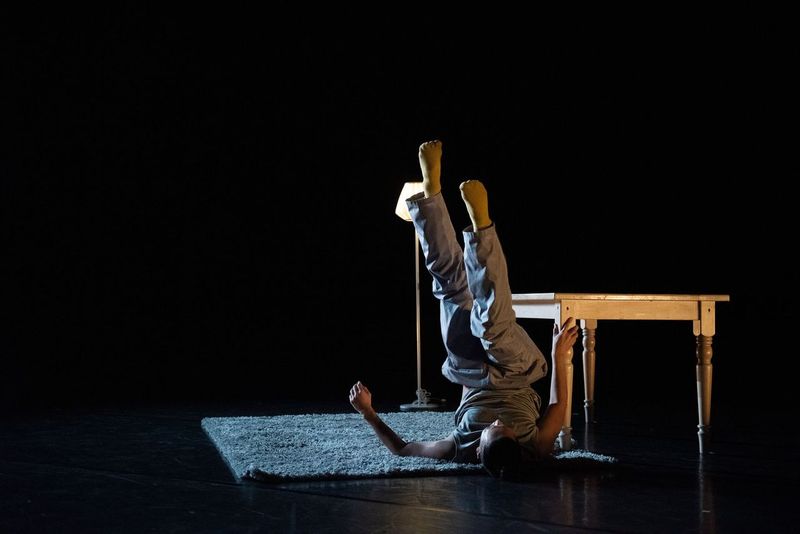TRAVERSE: RIRIE-WOODBURY COMPANY
In the middle of Ririe-Woodbury Dance Company’s 60th anniversary season, Traverse was a perfect Homecoming production, highlighting six new works and a company premiere, which exemplified the tremendous artistic culture that has defined the company.
With works by two alumni company members and the six current dancers, the creative principles which the founders Shirley Ririe and the late Joan Woodbury set forth resonated and echoed throughout the evening. There were works of astute sociocultural significance, pieces reflecting the ardor and rise and fall of emotions expended in the creative process, intimate choreographic statements about individual personalities and audience-pleasing displays of play and whimsy. The production, which featured guest performers including students from The University of Utah School of Dance, was dedicated to Woodbury, who died Nov. 1 at the age of 96.
A Century, A Day by Keith Johnson, who danced for eight years (1986-1994) with the company, provided the evening’s most poignant moments. Set as a duet, which featured company dancers Fausto Rivera and Sasha Rydlizky on the closing performance of the run, the work was built upon a movement language that evoked a multilayered yet still understated counterpoint of bittersweet, fond, unconditionally loving and deeply admiring emotions. Johnson had created the work six years ago during a summer intensive at SUNY-Brockport, sponsored by Doug Varone and Dancers. Reiterating a point that has been made consistently with Ririe-Woodbury’s dances, Rivera and Rydlizky brought the incredible ensemble chemistry the current slate of dancers has cultivated in recent seasons to this performance, which aligned perfectly with Johnson’s choice of music, the Air movement from Takashi Yoshimatsu’s Kamui-Chikap Symphony.
Likewise, Chia-Chi Chang’s III opened the program with an equally nuanced statement of contemplation — this time being, the counterpoint emerging from collective and individual experiences associated with acculturation and how newcomers develop their social process on their own terms. For the closing performance of the run, Peter Farrow, Alexander Pham and Fausto Rivera, per usual, set the standard for the company’s current stellar standards of ensemble chemistry, With music by Meredith Monk, the movement marked seamlessly the transitions from the tenser, more agitated and discomforting moments early in the experience of acculturation and fitting in to an introspective acceptance of changed realities and extensions of authentic identity and character. Chang, a company alumna from the early 2000s, created the work in 2003, as part of her master’s thesis in The University of Utah School of Dance. As with Johnson, Chang shaped the work to encourage the dancers to incorporate their interior contemplations about their respective acculturation experiences into the performance.
The quintet of short works by the current dancers was excellent, at every turn. Rydlizky’s It depends, with colleagues Farrow, Pham and Megan McCarthy, provided a unique riff on the good and bad of personality dynamics in relationships. Crisply paced, the work was a triptych of different dimensions, with duets featuring various combinations from the trio. And, an original composition from Salt Lake City musician Evan LoFranco titled Tsciabat Bows paralleled precisely the overall effect, notable given that Rydlizky had set the work based on improvisation tasks she had given to dancers.
Two dancers offered new works that played delightfully on common metaphors and tropes. The first was Farrow’s No Cigar, which proved how the idea of getting so close to clinching something but falling just a hair short could be replicated visually in choreography. He set the work on his five other Ririe-Woodbury colleagues: McCarthy, Pham, Rivera, Rydlizky and Miche’ Smith. The dancers were sheer delight to observe, which popped with Farrow’s really smart musical choices, including The Mills Brothers’ Nevertheless (I’m in Love with You) and Cloud of Unknowing and Pirate Jet, which were performed by Gorillaz. For a short piece, Farrow packed a good range of tangents emphasizing the No Cigar trope.
McCarthy, the most senior of the current company dancers, produced a wonderful solo piece based on the Gift Horse trope. The work, indeed, expanded how we can observe such a dancer who has appeared in so many different works throughout the seven seasons she has been with the company. I found it revealing about an artist, whom I have seen mature as an undeniably commanding presence on stage throughout her tenure. McCarthy describes herself as an introverted person but she also has found her own way, even as difficult as it could be at times, to be as liberating as possible on stage. That process was captured spot on, with the light prop she had on stage, as the quality and strength of the illumination flexed and fluctuated, according to her movement language. Underscoring the distinct artistic statement she brought forward was the original music composed, produced and performed by Paul Nabil Matthis, whom she met during her undergraduate training at the California Institute of the Arts over a decade ago.
Ririe-Woodbury dancers have performed quite a sizable volume of works in the repertoire that exude wit, whimsy and pop cultural pleasures. Two works added successfully to that dimension. Watch That Line by Fausto Rivera and Miche’ Smith was the perfect dance theater piece, especially for the nontraditional setup for the Traverse production. The audience was seated surrounding the performers onstage in the Jeanné Wagner Theatre, which gave viewers a rare close-up vantage point.

For Watch That Line, the effect for viewers felt like being part of a live television studio audience. While the work opened the second half, there were brief teasers in the first half — just like “coming up later in this broadcast.” The setup was downright ingenious, as Rivera and Smith built the work as an homage to shows like American Ninja Warrior and televised cage competition matches. It was complete with an announcer, trash-talking contestants and timed tasks. The music heightened the effects, with selections such as Big League (Yo Gotti, Moneybagg Yo, Mozzy, and Lil Poppa of CMG) the rap song which was an official selection for the 2022 NBA finals, a remix of the classic Eye of The Tiger by Survivor, Felix Rosch’s Humming Bird and Nina Simone’s performance of the theme from Camille Saint-Saëns’s opera Samson and Delilah.

The closing piece was a hoot for the audience — a rollicking glimpse at how a sports novice can find sassy fabulousness even in a plain old game of pickleball. Inspired by never having played any sports, Pham decided to set Perfect Match as “a whimsical reimagining of that missed experience.” The work, which was performed by Pham with Severin Sargent-Catterton, hit on every cylinder. As entertaining and witty as it was, Perfect Match is also an artistically demanding and challenging piece of choreography. It pulls in movement from several dance languages and vocabulary, including ballet, contemporary dance and pop moves. The collage explored in the three movements matched up beautifully with musical selections including Bohoman’s Elevator Music and bad guy, performed by Billie Eilish and written and produced by Finneas O’Connell.
EMERGE: REPERTORY DANCE THEATRE
It has become a New Year’s tradition for the Repertory Dance Theatre (RDT) to present Emerge, a production on the first weekend in January to present short works created by company staff members and dancers.
The eighth edition of Emerge, which also is available by purchase for on-demand streaming through Feb. 19, reinforced the artistic significance of having dancers, who already spend a great deal of time working with an immense range of choreographic movement languages and vocabularies in the RDT catalog, put their own imprint on the process of setting new work.
Among the standouts were Jon Kim’s Materials, a fine example of the improvisational process, with Kim moving and testing the ideals of positive and negative space in an area with three simple props (table, rug and lamp). It was as if Kim invited us into his residence, without qualms, reservations or awkwardness about us glimpsing into his intimate creative lab process. The improvisations varied in each of the three performances, which demonstrates how choreography emulates the writing process of editing and revising in continuous cycles.
Rhythm & Release, which RDT dancers Jacob Lewis & Caleb Daly set on students of the Winterdance 2024 workshop earlier that week, was a splendid example of working within a tight timeframe (in this case, six hours) and working with 18 dancers of varying degrees of experience. For a quickly made work, there was plenty of spontaneous pop and spark in the piece. Performers included Leah Ahlander, McKayla Browning, Ramses Contreras, Aspen Dalby, Jonathan Guerra, Karah Haug, LaReina Hignson, Ami Huppi, Julia Keys, Zachary Marshall, Grace Messenger, Heather Morley, Alexander Pham, Tessa Perez, Rebekah Shrader, Ray Toth, Spencer Waddell and Tori Woodall.

Likewise, Lauren Curley set Stranger upon an aspiring dance student whom she teaches at The Winner School, where RDT dancer Megan O’Brien also studied during her formative years. This was Ashli Ahlquist’s second consecutive Emerge performance and her solo reminded of the breadth and depth of skills that RDT dance artists acquire during their tenure. Stranger reminds us how opportunities such as Emerge are integral to sustaining the legacy of organic dance institutions such as RDT.
Regarding focus and approach, O’Brien took up Curley’s relay baton with the proper beat, setting How do I on a group of local freelance dancers including Bayley Banks, Olivia Beck, Severin Sargent-Catterton, Taylor Holladay Memmott, Heather Morley and Masio Sangster. One of the strengths of having many contemporary dance productions in the region is the availability of accomplished freelance dance artists and those O’Brien selected to perform this piece have regularly been involved with such programs.
Curley also set In Pieces There is Peace, for local dance teachers from middle and high schools, which was performed by Victoria Bean, Shelti Thompson, Anna Hughes, Kadyn Woolstenhulme, Roxanne Paulsen and Amber Wade. The work, which was made in three days, included benches as props. It demonstrated that while one could convene a meeting or a conference and discuss the experiences of teaching where many hurdles must be overcome, what more compelling way is there than to portray the exchange of ideas about dance education, affirmation and inspiration by communicating through movement the teachers had a part in setting with Curley as the facilitating choreographer.

Meanwhile, students from the Salt Lake School for the Performing Arts were featured in Lindsey Faber’s For You, Me and Us. This was a choreographic ode to Faber’s alma mater, with the performance featuring Courtney Carpentier, Gray Henry, Ellie Krull, Maggie Merchant, Holly Richard and Shayne Souvall.
Just as compelling in highlighting the thriving ecosystem of dance in Utah was Tribe by Nicholas Cendese, which was performed by Tanner Dance and The University of Utah Children’s Dance Theatre, which like several other Utah dance institutions is marking a major anniversary this season. A celebration of the 75th anniversary, Tribe envisioned the power of tight community cohesion in achieving a richness of dance possibilities in Utah. The work, flowing with rich youthful vibrance, was performed by high school students in the Children’s Dance Theatre: Allegra Dalpe-Lawlor, Clara Swain, Foss Goodwin, Gabrielle Boyden, Isabel Pugsley, Kathryn Hinckley, Kathryn Wright, Macy Peterson, Meg Madsen, Melanie Van Hook and Mira Tueller.
Cendese also presented the company premiere of There Is Beauty in Saying Good-Bye, a touching statement which incorporated an e.e.cummings poem and voiceover by Alexander Cendese. Featuring dancers from South Valley Creative Dance, the work premiered at rhe group’s spring concert in 2023 and paid tribute to the late W. Ivan Cendese. The work’s grieving family symbolism steers the movement, as performers sitting in chairs stand and move, each adding their expression of grief and love to console each other and to find their own comforting point of solace. Performers included Georgie Angwin, Finley Carlson, Elyssa Cassity, Elliette DeLainy, Lucy Gurney, Afton Harrison, Lilly Harrison and Theo Sanchez.




